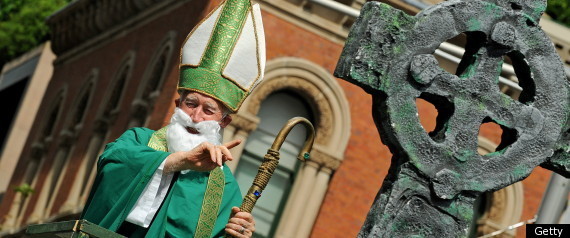Irish and African-American lesbian, gay, bisexual, transgender and queer (LGBTQ) communities share a lot in common when it comes to being excluded from iconic institutions in their communities.
For LGBTQ African Americans, it's the Black Church, and for LGBTQ Irish, it's the St. Patrick's Day Parade.
St. Patrick's Day has rolled around again, and like previous March 17 celebrations nationwide, its LGBTQ communities are not invited. As a contentious and protracted argument for now over two decades, parade officials have a difficult time grasping the notion that being Irish and gay is also part of their heritage.
Unlike the Black Church, however -- that has and continues to throw the Bible at its LGBTQ community to justify their exclusionary practices -- the St. Patrick's Day parade committee uses the First Amendment, debating that they are constitutionally guaranteed freedoms of religion, speech and association, and the tenet separating church and state.
Whereas several cities and states are not gay-friendly, Boston is known to be. But to the surprise of its LGBTQ denizens, Boston's St. Patrick's Day parades have no gay revelers marching.
In 1994, Boston's St. Patrick's Day parade was cancelled over this issue. The state's highest court ruled that the parade organizers could not ban LGBTQ Irish-Americans from marching. But in a counter lawsuit, parade officials won, accusing LGBTQ Irish-Americans of violating their rights to free speech under the First Amendment.
Heterosexual Irish-Americans discriminating against their LGBTQ communities is so reminiscent, to me, of how straight African Americans discriminate against their queer communities, with both forgetting their similar struggles for acceptance.
In the not so distant past, Irish Americans were scoffed at for showing their Irish pride, and they were discriminated against for being both Catholic and ethnically Irish. As they immigrated to these shores tension rose. By the mid-19th century anti-Irish bigotry was blatantly showcased throughout our cities as businesses put up placards saying: "No Irish Need Apply." During the 1900s in New York City, for example, newsboys, found on every corner or on a regular newspaper route, were often children of immigrants, and fought fiercely with each other for these jobs. Italian and Jewish immigrant kids would mock Irish boys screaming, "No Irish need apply." And the song "No Irish Need Apply" captured the daily hardship Irish Americans confronted looking for work:
"I'm a decent boy just landed
From the town of Ballyfad;
I want a situation, yes,
And want it very bad.
I have seen employment advertised,
"It's just the thing," says I,
"But the dirty spalpeen ended with
'No Irish Need Apply.'"
And like my ancestors of the African diaspora, the Irish were once enslaved, a.k.a. "Indentured Servants," and bound for the Americas by the British. King James II and Charles I enslaved the Irish by selling 30,000 Irish prisoners as slaves, making Ireland, as with Africa, and a huge source of human livestock. The forced interbreeding of Irish females with African males was widespread on British plantations in the Caribbean and U.S. until it was outlawed in 1681, giving birth to anti-miscegenation laws.
As a matter of fact, the Irish didn't become "white" in America until they fully participated in the wave of anti-black violence that swept the country in the 1830s and 1840s, where unskilled Irish men competed with free African Americans for jobs.
So I ask, what would St. Patrick do in this situation?
He would unquestionably welcome Irish LGBTQ, especially in a parade named after him.
St. Patrick was a man who used his experience of struggle to effect change.
As a 5th century English missionary to Ireland, St. Patrick was born in 387 and died on March 17, 461 CE. He was taken prisoner by a group of Irish raiders attacking his family's estate that transported him to Ireland where he spent six years in captivity.
After six years as a prisoner, St. Patrick escaped, but returned to Ireland as a missionary to convert the Irish to Christianity. As a priest, he incorporated traditional Irish rituals rather than eradicating their native beliefs. St. Patrick used bonfires to celebrate Easter since the Irish honored their gods with fire, and he superimposed a sun, a powerful Irish symbol, onto the Christian cross to create what we now know as the Celtic cross.
Many parade officials may think they are honoring the St. Patrick's Day tradition by excluding its LGBTQ communities, but like the Black Church, they will only be dishonoring themselves.
And, truth be told, no one knows how to throw a party or put on a parade like the LGBTQ community.
Fonte: The Huffington Post
quinta-feira, 17 de março de 2011
St. Patrick's Day Parades, Black Church Are Both Anti-Gay
Publicada por
Unknown
horas
22:22:00

Enviar a mensagem por emailDê a sua opinião!Partilhar no TwitterPartilhar no FacebookPartilhar no Pinterest
Etiquetas:
Absurdos,
EUA,
História,
Indignações,
Religião
Subscrever:
Enviar feedback (Atom)
Procurar na Bancada de Imprensa

Pesquisa personalizada
Etiquetas
Absurdos
Academia do Olimpo
Académica
Ao Sábado
Arbitragem
Artes e espectáculos
Atletismo
Bancada de Imprensa
Batota
Benfica
Braga
Choradinho encarnado
Ciência
coisas +/- gayzolas
Corrupção
Cromos
Crónicas
Cultura
Curiosidades
Desporto
DUX_XXI Playlist
Espanha
Estado de Alma
EUA
Fórmula 1
Fotografia
França
Futebol Internacional
Génios e quase génios
Greetings from TM
História
Humor
Imagens do dia
Indignações
Jornaleiros
Lazer
Lifestyle
Liga dos Campeões
Liga Europa
Liga Portuguesa
Literatura
Living in New York
Música
Orgulho Sportinguista
Palavra do dia
Pensamentos e Reflexões
Pessoal
Política
Porto
Religião
Saúde e bem-estar
Sensualidades
Serviço Público
Sociedade
Sporting
Sunday Morning
Taça da Liga
Táctica
Tecnologia e Informática
Totobola
Treinadores
Viagens
Violência

Sem comentários:
Enviar um comentário
Escreve aqui a tua opinião, seja ela qual for.